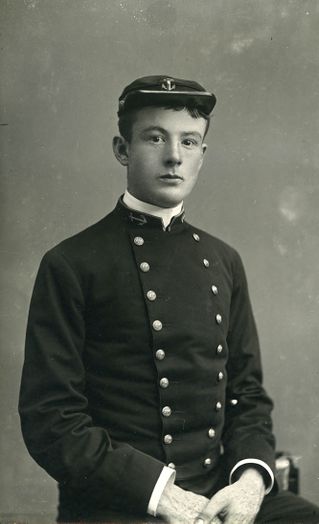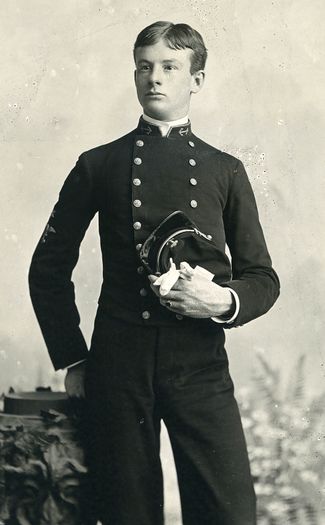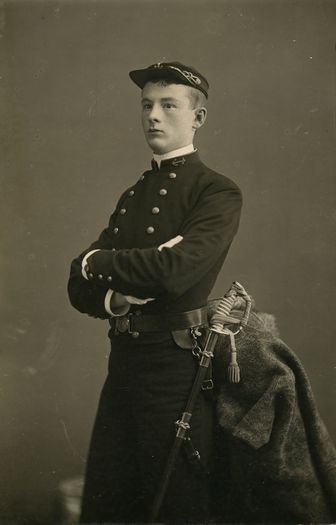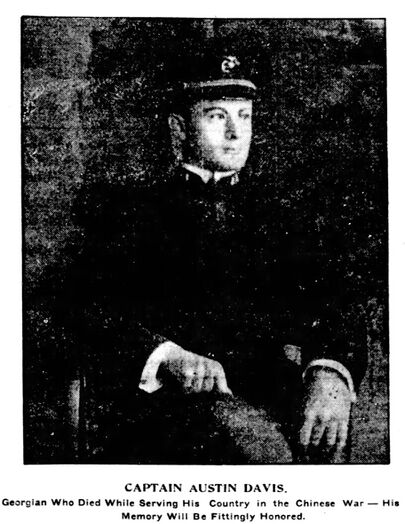AUSTIN R. DAVIS, CAPT, USMC
Austin Davis '92
Austin Rockwell Davis was admitted to the Naval Academy from Georgia on May 21, 1888 at age 17 years 2 months.
Loss
Austin Rockwell Davis was lost on July 13, 1900 when he was killed in action in Peking, China, during the Boxer Rebellion.
Photographs
Photos scanned and provided by Jennifer Bryan, Ph.D., Head of Special Collections & Archives/Archivist at the Naval Academy's Nimitz Library:
Other Information
From Arlington National Cemetery:
On June 22, British, Russian, German, Italian, and Japanese reinforcements arrived, making a combined force of about 2,000 men. The foreign city of Tientsin was entered and the siege raised. On Sunday morning, June 25, an advance was made to the relief of Admiral Seymour's command, who were intrenched at a point about 8 miles from Tientsin. This movement was accomplished with little opposition, and early on the morning of July 14 the walled city of Tientsin was captured by the allied forces.
"In this action, in which 22 officers and 326 men, under Col. R.L. Meade, participated, Capt. A.R. Davis, U.S. Marine Corps, was killed at the side of his commanding officer in the advanced trench; Capts. William B. Lemly and Charles G. Long, First Lieuts. Smedley D. Butler and Henry Leonard were wounded; a sergeant, a corporal, and 2 enlisted men were killed, and a sergeant, 2 corporals, and 12 enlisted men were wounded.
"To record the instances of gallantry displayed by our officers and men at the capture of Tientsin would almost be equivalent to a publication of the entire roster."
A graduate of the United States Naval Academy, he was appointed Second Lieutenant, United States Marine Corps on July 1, 1894. He was promoted to First Lieutenant on June 2, 1898 and to Captain on March 3, 1899.
His momument in Section 1 of Arlington National Cemetery was "erected by Officers of the United States Marine Corps."
In regard to the killing of Capt. L.A.R. Davis, U.S.M.C., Colonel Meade says:
"I regret to report the death of Capt. A.R. Davis, who was killed at my side in the advanced trench. He was killed almost instantly. I had his body brought in with the wounded, and he is buried here in Tientsin, his grave being marked. This was all I could do."
From researcher Kathy Franz:
At age two and one-half months old, Austin won a gold chain in a baby contest.
In his youth, he attended Barnard Street School and one year of high school. In July 1887, he was nominated to the Naval Academy by Congressman Norwood. After graduation, he was on the Brooklyn for a cruise through the Mediterranean.
In October 1892, Austin was on the Kearsage at La Guayra, Venezuela. He wrote home that his detachment was stationed in the bull fighting grounds, awaiting Crespo's advance with the rebel army. The rebels had captured Puerto Cabello, and fighting was happening at La Gora. The harbor had ships from France, Spain, Germany, America, and England. They all agreed to protect any merchant vessel arriving whether the country was represented in the waters or not.
In January 1894, Austin witnessed fighting in Rio de Janeiro from on board the cruiser New York. He returned to the U.S. in June.
From the Ledger-Enquirer, Coumbus, Georgia, May 18, 1898. In a letter to his sister Mary Louise, Austin wrote of the crossing of the equator on the Oregon. “Thursday, at noon, we crossed the equator and had a visit, as is the custom, from Neptune and his party. They came on board and were received by the captain. They then proceeded to initiate the members of the crew who had not crossed before. They lathered them with a soft mush made of grease, oil and salt water, and then shaved them with a big wooden razor. After that they were dumped into a tank of water, where they were ducked and rolled around by seven or eight of Neptune's followers.”
Austin sent his parents a piece of the Santiago's cable which the Oregon had raised. He also sent a beer mug captured from one of the Spanish ships, and from the captured Cristobal Colon, he sent a solid silver egg cup and a beautiful lace curtain. Austin remained in the States through December and took his exams for promotion to first lieutenant.
In February 1899, he left on the Yosemite for Guam, and in March, he was promoted to captain. In April he went to the Philippines in charge of the marines who took over the Cavite naval station from the military branch.
In July 1900, Austin's brother Henry sent a message to President McKinley asking him to appoint Henry to take Austin's place in the Marine Corps. Henry had served in the First Georgia Cavalry for five years.
In August that year, a Naval Academy classmate Roby Robinson (non-grad Class of 1891) started a fund to place a statue or oil painting of Austin in the new Carnegie library in Atlanta (now the Atlanta Central Library.)
He was survived by his parents and four siblings. He is buried in Arlington National Cemetery.
Austin was one of only 38 Captains in the entire Marine Corps at the time.
Career
He was assigned to the battleship Oregon "after some sea service;" he was aboard that ship when she made the voyage from San Francisco to Santiago in 1898 for the Spanish-American War. Afterwards "he was ordered to the Asiatic station."
The "Register of Commissioned and Warrant Officers of the United States Navy and Marine Corps" was published annually from 1815 through at least the 1970s; it provided rank, command or station, and occasionally billet until the beginning of World War II when command/station was no longer included. Scanned copies were reviewed and data entered from the mid-1840s through 1922, when more-frequent Navy Directories were available.
The Navy Directory was a publication that provided information on the command, billet, and rank of every active and retired naval officer. Single editions have been found online from January 1915 and March 1918, and then from three to six editions per year from 1923 through 1940; the final edition is from April 1941.
The entries in both series of documents are sometimes cryptic and confusing. They are often inconsistent, even within an edition, with the name of commands; this is especially true for aviation squadrons in the 1920s and early 1930s.
Alumni listed at the same command may or may not have had significant interactions; they could have shared a stateroom or workspace, stood many hours of watch together… or, especially at the larger commands, they might not have known each other at all. The information provides the opportunity to draw connections that are otherwise invisible, though, and gives a fuller view of the professional experiences of these alumni in Memorial Hall.
January 1893
July 1894
January 1895
January 1896
January 1897
January 1898
January 1899
January 1900
Austin is the only member of the Class of 1892 in Memorial Hall.

The "category" links below lead to lists of related Honorees; use them to explore further the service and sacrifice of alumni in Memorial Hall.






